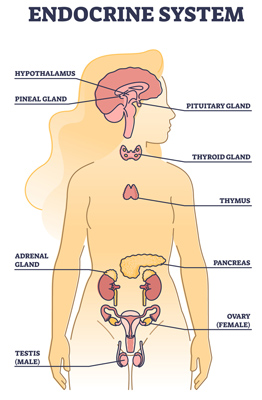Free Case Evaluation
You will never be charged a fee unless a recovery is made for you.
Cancer-causing chemicals in hair straighteners and hair relaxers have been linked to uterine (endometrial) cancer and ovarian cancer. Women who have regularly used chemical hair straighteners and hair relaxers and have developed uterine or ovarian cancer are filing lawsuits.
Cancer-causing chemicals and substances used in hair straighteners include:

This is only a partial list of some of the cancer-causing chemicals and substances that have been found in chemical hair straighteners and relaxers. These chemicals are known as endocrine-disrupting chemicals, because they disturb the functions of the endocrine system, which regulates the body’s production of hormones.
The endocrine system regulates the body’s production of hormones, which are the body’s chemical messengers. Glands in our bodies secrete hormones into the bloodstream. The major endocrine glands are the adrenal glands, the pancreas, and the pineal, pituitary, thymus, and thyroid glands. People also produce hormones in their ovaries or testes.
Hormones work slowly and affect many different bodily processes and aspects, including:
Hormones are powerful. A small amount of hormones can effect big changes in individual cells or even throughout the body. That is why too much or too little of a hormone can cause serious problems.
Endocrine-disrupting chemicals (EDCs) disturb the functions of the endocrine system. EDCs are chemicals or chemical mixtures that interfere with the way hormones work.
Even low amounts of EDCs may be unsafe. As noted, the body’s normal endocrine functioning involves very small changes in hormone levels causing significant biological and developmental effects. Disruptions to the endocrine system and to the body’s hormone levels can have serious consequences. Exposure to EDCs has been linked to numerous adverse health outcomes, including certain types of cancer.
People may be exposed to endocrine-disrupting chemicals through the air they breathe, food they eat, and water they drink. EDCs can also enter the body through the skin, such as when hair straightening chemicals containing EDCs are applied to a person’s scalp.
Sources
American Cancer Society. (2022, October 26). Study Finds Possible Link Between Hair Straightening Chemicals and Uterine Cancer. Retrieved from https://www.cancer.org/latest-news/study-finds-possible-link-between-hair-straightening-chemicals-and-uterine-cancer.html
Calafat, A., et al. (2010, May). Urinary concentrations of four parabens in the U.S. population: NHANES 2005-2006. Retrieved from https://pubmed.ncbi.nlm.nih.gov/20056562/
Caserta, D., et al. (2022, March 9). Endocrine Disruptors and Endometrial Cancer: Molecular Mechanisms of Action and Clinical Implications, a Systematic Review. Retrieved from https://www.mdpi.com/1422-0067/23/6/2956/htm
Chang, C., et al. (2022, October 17). Use of Straighteners and Other Hair Products and Incident Uterine Cancer. Retrieved from https://academic.oup.com/jnci/advance-article/doi/10.1093/jnci/djac165/6759686?login=false
Diamanti-Kandarakis, E., et al. (2009, June). Endocrine-Disrupting Chemicals: An Endocrine Society Scientific Statement. Retrieved from https://www.ncbi.nlm.nih.gov/pmc/articles/PMC2726844/
Dodson, R., et al. (2012, March 8). Endocrine Disruptors and Asthma-Associated Chemicals in Consumer Products. Retrieved from https://www.ncbi.nlm.nih.gov/pmc/articles/PMC3404651/
Endocrine Society. (2022, January 24). Endocrine-Disrupting Chemicals (EDCs). Retrieved from https://www.endocrine.org/patient-engagement/endocrine-library/edcs
Helm, J., et al. (2018, August). Measurement of endocrine disrupting and asthma-associated chemicals in hair products used by Black women. Retrieved from https://www.sciencedirect.com/science/article/pii/S0013935118301518?via%3Dihub
Mallozzi, M., et al. (2017, March). Endocrine Disrupting Chemicals and Endometrial Cancer: An Overview of Recent Laboratory Evidence and Epidemiological Studies. Retrieved from https://www.ncbi.nlm.nih.gov/pmc/articles/PMC5369169/
Mandal, A. (2022, December 6). What are Hormones? Retrieved from https://www.news-medical.net/health/What-are-Hormones.aspx
MedlinePlus. (2016, October 7). Hormones. Retrieved from https://medlineplus.gov/hormones.html
Merrill, M., et al. (2019, November 12). Consensus on the key characteristics of endocrine-disrupting chemicals as a basis for hazard identification. Retrieved from https://www.nature.com/articles/s41574-019-0273-8
National Institute of Environmental Health Sciences. (2022, August 18). Endocrine Disruptors. Retrieved from https://www.niehs.nih.gov/health/topics/agents/endocrine/index.cfm
Pelc, C. (2022, October 20). Frequent hair straightener use doubles uterine cancer risk. Retrieved from https://www.medicalnewstoday.com/articles/frequent-hair-straightener-use-doubles-uterine-cancer-risk
Rachoń, D. (2015). Endocrine disrupting chemicals (EDCs) and female cancer: Informing the patients. Retrieved from https://www.ncbi.nlm.nih.gov/pmc/articles/PMC4801991/
Reichel, C. (2018, May 15). Hormone-disrupting chemicals found in hair products for black women. Retrieved from https://journalistsresource.org/environment/endocrine-disruptors-black-women-hair-research/
Simon, S. (2019, December 6). Study Finds Possible Link Between Hair Dye, Straighteners, and Breast Cancer. Retrieved from https://www.cancer.org/latest-news/study-finds-possible-link-between-hair-dye-straighteners-and-breast-cancer.html
White, A., et al. (2021, October 5). Use of hair products in relation to ovarian cancer risk. Retrieved from https://pubmed.ncbi.nlm.nih.gov/34173819/
You will never be charged a fee unless a recovery is made for you.